By the 100 anniversary of the creation of the Main Military Meteorological Administration
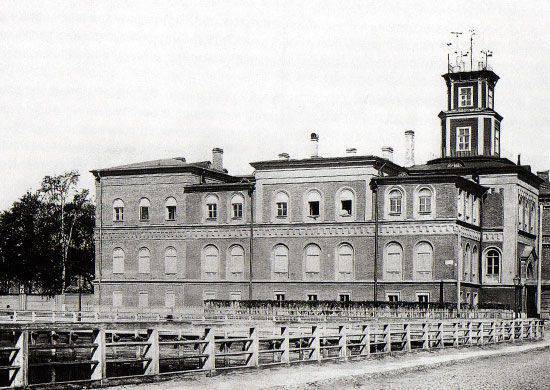
At the beginning of the twentieth century, Russia was one of the leading meteorological powers in the world. She had her own network of observation stations and observatories, a system of training, conducted basic research in the field of meteorology. The leading institution of domestic meteorology was the Nikolaev Main Physical Observatory (HFO), in which scientific and methodical work was conducted under the guidance of famous scientists. Among other HFO units, there was a marine meteorology department staffed by naval officers and maintained at the expense of the Marine Ministry. The department conducted research in the field of marine meteorology, led the activities of coastal observatories and stations, served as a storm warning service on the seas.
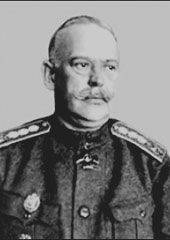
In 1913, the post of director of the Observatory was taken by one of the founders of seismology, the outstanding geophysicist Prince Boris Borisovich Golitsyn. A world-renowned scientist set about reforming the Russian meteorological industry. Together with the largest domestic meteorological scientists A.I. Voeikov and MA Rykachev he developed a plan for a significant expansion of the network of meteorological observations in Russia, however, the implementation of his plans was hampered by the start of the First World War.
With the opening of hostilities from the institutions of the Military Department, the Main Physical Observatory began to receive requests for the provision of all sorts of data.
The army in the first place was interested in information about the time of freezing and opening of water bodies, on the climatic features of the theater of operations. The interests of providing troops, and especially combat use aviation, demanded that the staff of the Observatory daily weather forecasts for 2 days in advance.
Similar work was carried out on the other side of the front. In Germany, which, unlike Russia, entered the war already prepared in meteorological terms, scientists were widely involved in meeting the needs of the army, fleet and aviation. It is noteworthy that Russia and Germany, as leading meteorological powers, actively cooperated with each other until the very beginning of the war. In particular, in 1914, the outstanding Russian mathematician A.A. Friedman, together with his German counterpart T. Hesselberg, conducted a study on the application of the equations of hydrodynamics to large-scale atmospheric processes. Tables created by the efforts of two scientists entered the meteorological science under the name of the Friedmann-Hesselberg Tables. They were published in both countries just a month before the meteorologists of Russia and Germany found themselves on opposite sides of the armed confrontation.
If in the first months of the war, HFO specialists met the needs of the military along with their research activities, by the end of 1914, army service became the main content of their work. In agreement with the General Headquarters and the Marine General Headquarters, the Observatory began to send forecasts to the headquarters of the Supreme Command and the commander of the North-Western and South-Western fronts, to aviation units, separate armies, Baltic and Black Sea fleet units, and intelligence services. In December 1914, the HFO provided its forecasts to 25 military authorities. A paradoxical situation has arisen where purely civilian people worked solely in the interests of the army and navy, developing and transmitting a wide range of hydrometeorological information to the addressees in the current army, while maintaining secrecy. “New tasks,” Golitsyn wrote, “forced the Daily Bulletin Branch to focus all attention on predictions for the army and navy, and the synoptic department to attach the data obtained for special agricultural purposes to extend the prediction term to military predictions.”
Thanks to the efforts of B. B. Golitsyn was able to translate the work of the Observatory on a military basis. His subordinates worked hard, creating climate surveys on the fronts on the basis of long-term data from pre-war observations. In the reviews, the characteristics of air and soil temperature, precipitation, wind direction and speed, cloudiness, snow cover, blizzards, opening and freezing of rivers were given. Meteorological elements were presented in the form of tables and maps for each month with a description of the climatic features of the area. At the request of aviation, information was provided on the wind to a height of 3000 meters and on the nature of the clouds.
Academician B. B. Golitsyn connected the best scientists of Russia, including Professor A.I. Voeikov. The latter, being an eminent climatologist, understood the impossibility of creating full-fledged fundamental works under wartime conditions and proposed, in the interests of the current army, "to publish a brief climatology that includes only the most important climatological elements from observations of a relatively limited number of selected stations." The proposal was accepted, thanks to which HFO employees managed to compile and send military geographic descriptions to 36 troops for various combat areas.
However, in the 1915 year, with the transition to encrypted transmission of meteorological data and an even greater deepening of the Observatory in the process of supporting military operations, the need to create a military meteorological organization became apparent. Academician B. B. Golitsyn delivered a memo addressed to Nicholas II, attaching to it the “Project of the organization of military meteorology”. He proposed to the Tsar “to introduce during the war all the meteorological service in the military department, establishing a special organization for this, which includes only the necessary, mainly senior personnel of the relevant branches of the Observatory, as persons directly possessing military secret affairs”.
All proposals of the Director of the GFO were satisfied, and on December 22 of 1915, the Emperor signed the Regulations on the Main Military Meteorological Administration (GVMU), approving his staff. At the same time with GVMU, which began to be called Glavmet in official documents, the staff of the military meteorological department at the headquarters of the army and the military meteorological station at the aviation company, as well as the special equipment for them, were approved.
According to the Statute, the Main Military Meteorological Administration became one of the field administration bodies of the active army and had as its task “service in the military meteorology of the active army and navy, aviation and aeronautical units, chemical teams”. Convinced at the initial stage of the war, what role the weather plays in the combat activities of aviation, Augustus head of aviation and aeronautics of the active army, Grand Duke Alexander Mikhailovich, obtained direct subordination of the Main Directorate of his Office. Despite this, GVMU was in charge of “the whole matter of military meteorology.”
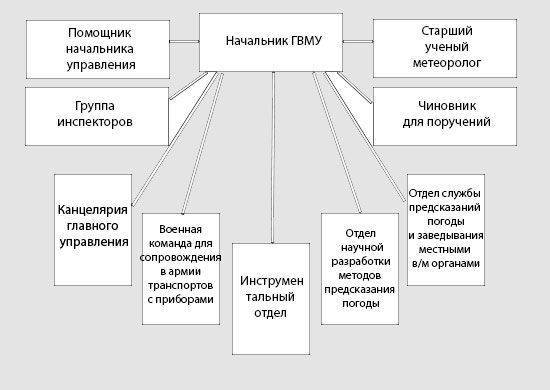
Glavmet was created on the basis of the HFO, and all of its officials were appointed from among the staff of the Observatory, with the combination of new military and former civilian duties. The staff of GVMU had a total of 12 employees who received the status of military officials upon appointment. The Office’s small size was due to the fact that it relied on the scientific, technical and methodological potential of the Main Physical Observatory in its activities. The management of the structural units of the State Administration of Foreign Affairs of Ukraine was entrusted to the heads of the relevant structural divisions of the GFO. The department of weather prediction and local military meteorological agencies were headed by colleague councilor Ismail Semyonov-Tian-Shansky, the outdoor advisor Boris Multanovsky became the head of the department for scientific development of weather prediction methods, and the instrumental department was headed by outdoor advisor Vladimir Popov. All three were renowned meteorological scientists.
With the formation and staffing of Glavmet, the content of the work of forecasters HFO practically did not change. As before, once a day around 18 hours, they sent consumers in the army on the list of telegrams. The encrypted telegram contained a summary of the observations of 28 stations (18 Russians and 10 foreign) for 21: 00 of the previous day and for 7: 00 current, an overview of the atmospheric processes and weather prediction for 24 hours, starting with 07: 00 the following days. As a rule, it contained information about air temperature, barometer fluctuations, amount of cloudiness, precipitation and wind. Sometimes information about mists, thunderstorms, opening and freezing of rivers was included ... The prediction was presented in an arbitrary form. At the same time, there were formulations completely unusual to the modern ear: "the wind fluctuates within the western half on Saturday, with its departure from the north to the south, the wind speed fluctuating from three meters to one, the cloudiness fluctuating from full to precipitation."
The most important task, the solution of which to the Main Department of Civil Aviation has begun from the first days of its existence, was the formation of the so-called “local military meteorological bodies”. Glavmet's staff deployed a large-scale search for candidates in the army, educational institutions and scientific organizations that are suitable for replacing military meteorological posts in the military. With the arrival at the disposal of BB Golitsyn's first candidates, from them began to form military meteorological departments and military meteorological stations, which, as personnel trained, supplied with instruments and documentation, were sent to the active army.
How quickly the formation of such units was carried out can be judged by the example of the military meteorological department of the 8 army headquarters. March 1 The Ensign of the 1916 Finnish Infantry Brigade Valery Mironovich arrived at the disposal of the Chief of the Main Directorate of the GVMU, who was ordered to "start immediately to form the department and prepare the lower ranks for making observations." Already on 3 on April, an order was issued for the Central Committee of Management No. 4: “§ 48. ... Ensign Mironovich reported on the report that the formation of the division at the army headquarters entrusted by my order was over. § 1. Ensign Mironovich, head of the military meteorological department, appointed by the 2 army headquarters and ordered him to go to the place of 8 service this April and leave me to inform. The Chief of the Main Investigative Department of Privy Councilor, Academician Prince Golitsyn ".
Such military meteorological offices, which were formed and sent to each of the armies, as well as military meteorological stations sent to aviation companies and aircraft fleets, consisted of an officer or military officer, as well as teams of several lower ranks. The first had to have specialized education or own any related specialty, the second required knowledge of mathematics and the ability to quickly master the method of observing the weather, because of which the lower ranks of the local military meteorological bodies were mostly students who volunteered for the front . The work of these people in the army consisted in making meteorological observations, receiving and deciphering Glavmet’s telegrams with meteorological information and communicating this information to the management of the relevant departments. To increase the knowledge of pilots and aeronautics in matters of meteorology within the walls of the Main Military Meteorological Directorate, an “Air Navigation Course” was prepared.
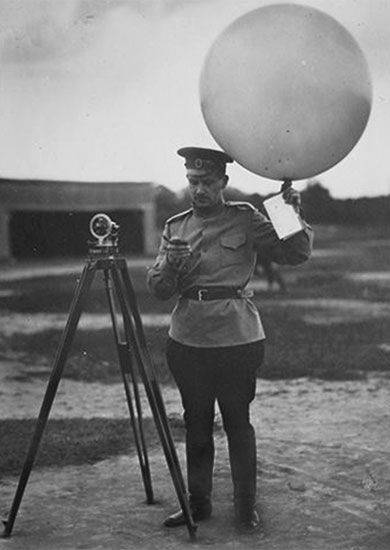
wind speeds and directions before flying. 1915 year.
Boris Borisovich Golitsyn gave all his energy to the creation of the GVMU. Using the authority of a well-known scientist, he had the opportunity to discuss the prospects and urgent problems of military meteorologists at the highest level. January 17 1916, he visited with the report of Nicholas II at his headquarters in Mogilev. One of the officers of the Stakes M.K. In his memoirs, Lemke wrote: “Academician Prince Boris Borisovich Golitsyn is now here, having lunch and having breakfast with us. A protective uniform with high boots very young and very suitable for him. ” However, hard work undermined the health of B. B. Golitsyn. In one of the many trips to the army he fell ill with pneumonia, which became fatal for him. In May 1916, the academician died, bequeathed to his subordinates to continue his undertaking.
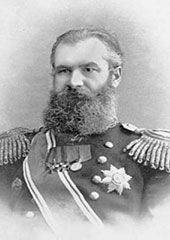
The successor to B. B. Golitsyn as the chief of the Main Military Meteorological Administration became a no less eminent scientist - shipbuilder, mechanic, mathematician, academician, lieutenant-general of the fleet Alexey Nikolaevich Krylov. Despite the fact that he was not a meteorologist, and was ironic about his purpose, he made a great contribution to the meteorological support of the army and navy.
Under the leadership of Lieutenant A.N. Krylov was carried out a large methodical work to create guidance documents in the field of military hydrometeorology for the troops.
Glavmet’s team developed the “Provision on the Front Meteorological Service of the Front”, the “Temporary Instruction on the Duties of the Meteorologist of the Front”, and many other guidance documents.
Not being a professional meteorologist, but being a famous scientist, A.N. Krylov understood that the conditions of wartime make it impossible to realize the research potential of the institution entrusted to him. He described the use of highly qualified world-renowned scientists to support the army when they were separated from basic science as follows: “The observatory, owning gold placers, has to limit itself to“ prospector picking ”in them, because it does not have the means to develop them properly.”
The merit of Lieutenant A.N. Krylov and in the conservation of meteorological frames. He made considerable efforts to ensure that highly qualified meteorologists were not called to the front, but continued to work in their specialty. On November 2 of 1916, he sent a telegram to the aviation headquarters with the following content: “According to the last call, HFO officers are to be transferred to the 53 troops. Glavmet's activities are based on the correct and continuous activities of HFOs. The call of experienced workers will force the Observatory to practically cease its work, which will most negatively affect the work of Glavmet and the support of the front. Then it will be useless to request the Observatory about the prediction of snow blizzards and drifts on railways, about the depth of soil freezing, about the level of spring waters and other things like that. To enjoy the fruits, you can not undermine the roots. " Lieutenant-General A.N. Krylov believed that the cause of scientists to bring victory to their scientific research. In particular, he described the Observatory’s extensive work on creating climate descriptions of war zones as a “patriotic feat.”
Since September 1916, military censorship began to actively intervene in the operational work of army meteorologists, which adversely affected the timing of the passage of meteorological information between HFOs and local military meteorological agencies. Lieutenant-General A.N. Krylov reported to the Stavka: “One of two things must be prescribed - censorship should be passed so that meteorological dispatches are allowed into GFO without censorship and without delay, or GFO and Glavmet associated with it will stop predicting the weather, because they cannot be received if it is not timely received meteorological dispatches. There can be no compromise or half-hearted solution. ” Thanks to these efforts, he managed to preserve the backbone of the Observatory research team.
In mid-February 1917, Lieutenant-General A.N. Krylov appealed to the Academy of Sciences and to the Field Inspector-General of the Military Air Fleet with a request to relieve him of the post of Chief of Glavmet due to high employment in other areas of scientific activity and not enough competence in meteorological specialty. The affairs of the Chief of the Main Affairs Department were transferred to Ismail Petrovich Semenov-Tyan-Shansky.
At the initiative of this scientist, who stood at the very beginnings of the Main Department of State Institution, a commission was appointed to discuss the reorganization of the Department. The fact is that, forming the staff of the Main Directorate in December 1915, Prince B. B. Golitsyn could not have imagined that the war would be delayed for such a long time that military operations would gain such scope, and that meteorological support would be required in such a significant amount. By the 1917 year, GVMU had long since “overgrown” its original staff, calling on many employees of the Main Physical Observatory to serve in excess of the state. The new states, approved in April 1917 of the year, provided for a larger number of inspectors to work in the active army, as well as a team of lower ranks to escort cargo of meteorological equipment (annex 1). The next step I.P. Semenov-Tian-Shansky considered the reorganization of meteorological agencies in the army in the field, but revolutionary plans prevented the implementation of his plans.
After the withdrawal of Russia from the First World War in 1918, the Main Department of Internal Affairs was handed over to the People’s Commissariat for Military Affairs. In the majority, Glavmet’s military ranks accepted the revolution and continued their activities under the red banner. In essence, they were rather scientists of the Main Physical Observatory than white officers, therefore they remained faithful to their Alma Mater.
In September, 1918 was transformed by the Decision of the Military Legislative Council of the Central Administration of the Central Administration of the State into the Military Meteorological Department of the Central Supply Office (NOC) of the Red Army with redeployment to Moscow. From this point on, 29 staff provided by the state again started under the direction of I.P. Semenov-Tyan-Shansky to the meteorological support of hostilities, this time in the Civil War. According to the Statute of the NOC, its Military Meteorological Department was vested with the rights of the military department’s main directorate, while it was charged with managing the network of observation stations, training meteorological personnel, preparing necessary maps and bulletins, developing manuals, supplying troops with meteorological and aeronautical equipment, and also “instructing aviation units in the performance of air operations in the sense of indicating the most successful in meteorological terms for them, in the same STI instructing gas operations teams with a suffocating gases, warning the military units of the occurrence of favorable moments for his gas attacks. " To fulfill these tasks, the Military Meteorological Department was assigned a network of aerological stations with the Main Aerological Station in Moscow, as well as a warehouse park for storing, checking and repairing meteorological and aeronautical assets.
As in the First World War, during the Civil War, the Department meteorologists worked a lot on the front lines. The report of the NOC from 9 July 1920 of the year stated: "The NCC has the following positions, which are often caused by frequent travels from those occupying these positions: ... Inspector of the Military Meteorological Department, scientists, specialists and Head of the Instrumental Department."
21 June 1921 year V.I. Lenin signed the Decree of the Council of People's Commissars of the RSFSR "On the organization of the RSFSR meteorological service", a logical continuation of which was the Decree of October 13 of 1921 "On the transfer of the Military Meteorological Department from the jurisdiction of the people's commissariat for military affairs to the people's commissariat of education." Glavmet, six years old, regularly carrying out meteorological support for the Russian and then the Red Army, was transformed into the Department of Military Meteorology of the Main Physical Observatory, returning to where it was once created.
Summing up stories GVMU, it should be recognized that it had a positive impact on the conduct of hostilities of the Russian army, aircraft and navy. For the short time of Glavmet’s existence, dozens of local military meteorological bodies were formed, hundreds of meteorological experts were trained, many guidance documents, works and aids were created, thousands of forecasts, maps and bulletins were developed and sent to the army. The activities of the Main Military Meteorological Office during the First World War and its successor, the Military Meteorological Department of the NOC during the Civil War, laid the foundations for the national hydrometeorological support system for military operations, creating a precedent for mobilizing the civil meteorological industry in the interests of the current army. It is natural that the date of Glavmet’s creation - December 22, the Russian military meteorologists celebrate as their professional holiday.
Information